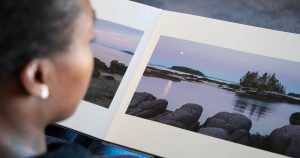
Due to a seasonal farming industry, Robinvale’s population is one of the most diverse in Australia. Located on the Murray River (Australia’s longest), the town is at a confluence point of five different Indigenous language groups with a strong First Nations presence. This new work has seen Koenning build connections and unexpected bonds with the people she has met. She has even been accepted as an unofficial town chronicler, invited to all the town’s events, and to family parties and gatherings. This has, like her other projects, allowed her to delve deeper and to start to tap into the complexity of stories that exist in Robinvale. Its history is plagued by the legacy of colonisation and settler stories and traces of dispossession of Indigenous peoples. Today, contemporary narratives are formed by new international migrants, and other issues such as drought, the environment, and more broadly, how humans live together in and build community. “Robinvale came unexpectedly into my life, and has changed me,” Koenning says.
The photographer’s work is currently on show in the massive Melbourne Now exhibition at the National Gallery of Victoria (NGV), which features over 200 artists and runs until 20 August 2023. The featured series, titled while the mountains had feet and curated by NGV’s Maggie Finch, is partly extracted from a large body of work titled between the river and the sea, which she began at the end of 2019 as a response to a number of traumatic experiences, including the devastating bushfires and the death of a loved one. As she made the work, it evolved and became about processing melancholy and lightness, intimacy and grief, and exploring community, geography, walking, similarity and difference, and witnessing over time. The photographs exhibited at NGV are taken from four different projects. “I call them ‘migrant pieces’,” Koenning explains. “I was interested in exploring a constellation on the wall, creating a dialogic space that enables a fellowship of images.”
The result is a fluid presentation echoing Koenning’s artistic process. It is about accessing and delving into different stories, and working simultaneously across fragments and multiplicities that ultimately find connection. “I’ve always been really interested in clustering, layering and reassembling,” she reflects. “As Teju Cole says: ‘Artists have a duty to be weavers and repairers of stories’.”



